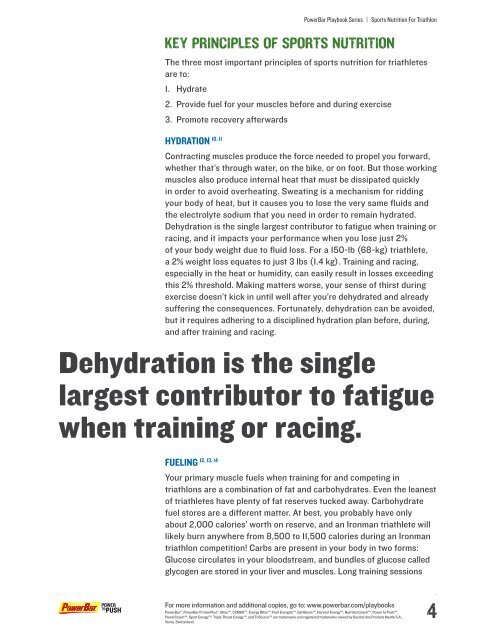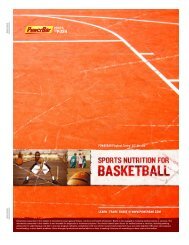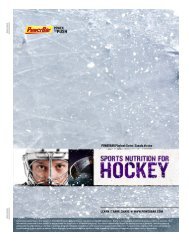PowerBar Playbook Series | Canadian Version - PowerBar.Com
PowerBar Playbook Series | Canadian Version - PowerBar.Com
PowerBar Playbook Series | Canadian Version - PowerBar.Com
You also want an ePaper? Increase the reach of your titles
YUMPU automatically turns print PDFs into web optimized ePapers that Google loves.
<strong>PowerBar</strong> <strong>Playbook</strong> <strong>Series</strong> | Sports Nutrition For Triathlon<br />
Key Principles of sports nutrition<br />
The three most important principles of sports nutrition for triathletes<br />
are to:<br />
1. Hydrate<br />
2. Provide fuel for your muscles before and during exercise<br />
3. Promote recovery afterwards<br />
10, 11<br />
HYDRATION<br />
Contracting muscles produce the force needed to propel you forward,<br />
whether that’s through water, on the bike, or on foot. But those working<br />
muscles also produce internal heat that must be dissipated quickly<br />
in order to avoid overheating. Sweating is a mechanism for ridding<br />
your body of heat, but it causes you to lose the very same fluids and<br />
the electrolyte sodium that you need in order to remain hydrated.<br />
Dehydration is the single largest contributor to fatigue when training or<br />
racing, and it impacts your performance when you lose just 2%<br />
of your body weight due to fluid loss. For a 150-lb (68-kg) triathlete,<br />
a 2% weight loss equates to just 3 lbs (1.4 kg). Training and racing,<br />
especially in the heat or humidity, can easily result in losses exceeding<br />
this 2% threshold. Making matters worse, your sense of thirst during<br />
exercise doesn’t kick in until well after you’re dehydrated and already<br />
suffering the consequences. Fortunately, dehydration can be avoided,<br />
but it requires adhering to a disciplined hydration plan before, during,<br />
and after training and racing.<br />
Dehydration is the single<br />
largest contributor to fatigue<br />
when training or racing.<br />
12, 13, 14<br />
FUELING<br />
Your primary muscle fuels when training for and competing in<br />
triathlons are a combination of fat and carbohydrates. Even the leanest<br />
of triathletes have plenty of fat reserves tucked away. Carbohydrate<br />
fuel stores are a different matter. At best, you probably have only<br />
about 2,000 calories’ worth on reserve, and an Ironman triathlete will<br />
likely burn anywhere from 8,500 to 11,500 calories during an Ironman<br />
triathlon competition! Carbs are present in your body in two forms:<br />
Glucose circulates in your bloodstream, and bundles of glucose called<br />
glycogen are stored in your liver and muscles. Long training sessions<br />
For more information and additional copies, go to: www.powerbar.com/playbooks<br />
<strong>PowerBar</strong> ® , <strong>PowerBar</strong> ProteinPlus ® , Bites, C2MAX, Energy Bites, Fruit Energize, Gel Blasts, Harvest Energy, NutritionCoach, Power to Push,<br />
PowerCoach, Sport Energy, Triple Threat Energy, and TriSource are trademarks and registered trademarks owned by Société des Produits Nestlé S.A.,<br />
Vevey, Switzerland.<br />
4







